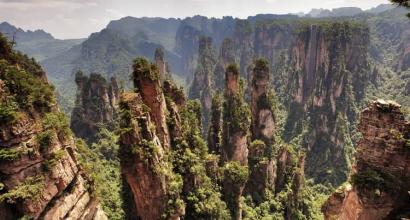Pedestrian bridge across the Urals. History of emergency and descent to the Urals in Orenburg
Connecting parts of light: Pedestrian bridge across the Urals in Orenburg April 17th, 2018
Pedestrian bridge across the Urals in Orenburg on the right home urban attraction. Rather, even a symbol. His image is in all notes and essays about the city, on calendars and postcards. In 1835, a bridge was built at this place, in the design of which the famous writer Vladimir Dal was busy. He lived at the time in Orenburg. The first bridge was wooden flooded, it was put after the siblings and cleaned up for the winter. Then the bridge became pile, but also from the tree. Only in 1982 they built a metal bridge, which we observe and to this day. 
The length of the bridge is 220 meters, the weight is about 900 tons, the design is impressive - the bridge hanging guy, but it looks like something else. And on it installed Stela "Europe Asia".

The river divides the city into two parts about the middle. And you can make unique travel from Europe to Asia several times a day.

From the European part there is a monument to the legendary pilot of Chkalov, the cable car, the observation deck, and in Asia there is a zuraral grove. Monument to Valery Pavlovich was established in 1953. Orenburg, by the way, from 1938 to 1957 was called Chkalov. The six-meter monument stands on the seventere pedestal.

We will not go down on the curator on the curator, we will walk a little on foot and return.

Yes, with time free, it was completely trouble.

Now the reconstruction of the embankment and descent to the bridge from the observation seems to be in conclusion or close to that.

In general, it is not bad, it's you old photos have not seen, but still a bunch of shortcoming and corona steps.

Maybe correct. During our walk on the bridge, the delegation went important, similar to the verifier commission, was measured, recorded, photographed.

In general, the construction of this bridge itself was unique. It was erected simultaneously from two shores. From the south side was built by a classic way, and with the opposite one, they first built along the coast and then they turned around, connecting two halves.

They say that the bridge itself will also be closed for reconstruction in the near future. This, I think correctly.

After all, it looks at all on some places.

Here are just the townspeople for the beloved place of relaxation in a composure grove, you will have to get either on the rope or on the automotive bridge.

Or maybe the climb, because just here is the city beach.

Okay, let's see in the summer.

In 1835, the first bridge was built in Orenburg through the Urals. While Vladimir Dal lived in the city, who participated in his design and construction. The bridge was flooded and wooden, at the end of the spring flood every year it was renovated. Later he was replaced by the pile. Permanent bridge connected the banks of the Urals only in 1982.
The suspended metal cable bridge is held by two supports from which high pylons, connected by the letter "P", are deployed. From each pilon to the bridge, steel cables that support it. The weight of the bridge is about nine hundred tons, and its length is two hundred twenty meters. Interestingly, a bridge was built on two sides of the river. From the southern shore, its construction went by the usual method - across the river. The bridge flutter on the north shore was first built along it, and then they turned and joined the other half.
The bridge seems practically weightless, despite quite significant sizes. In Orenburg, he is the most recognizable urban attraction. In its middle, a stela is established, testifying that the Ural is a symbolic border separating Asia and Europe.
At the Asian side of the bridge there is a zuraral grove with its coastal landscapes and shady trees. Sevropia - Naerenburg embankment, which has become a favorite holiday destination for most citizens.
The international geographical union, however, does not recognize this border since 1959. After taking the opinion of Russian scientists about its passage along the Emba River, the Ural Mountains and Mulgarians. According to this statement, the Ural River can be considered an aquatic boundary between the lights of light only in its upper course. Thus, Orenburg is a completely European city. But Orenburgers are still confident in the opposite, because it is so great: one step to the side - and you are in Europe, step in the other side - in Asia.














The first bridge across the Ural River in the city of Orenburg was built back in 1835. In the design and construction of the bridge, a Russian writer Vladimir Dal took part in Orenburg. The bridge was wooden and flooded, it was notified every year at the end of the spring flood. Later, this bridge was replaced by pile, it was also wooden and temporary.
A permanent bridge across the Ural appeared in Orenburg only in 1982. He was built on the initiative of the Chairman of the City Council, Yuri Guardi. This is a metallic hanging cable bridge. It is erected on two supports, from which two high pylons are rising, connected at the top of the letter "P". Steel cables that support the bridge are deployed from each of the pylons. The length of the bridge is two hundred twenty meters, and the weight is about nine hundred tons. Interestingly, the bridge was built on both sides of the Urals. From the South Coast, construction was carried out in the usual way - across the river. And on the north shore, the bridge was built along the coast. And then unfolded by connecting on the other a half.
Despite its rather significant sizes, the bridge looks almost weightless. It became one of the most recognizable attractions of the city. In the middle of the bridge there is a metal stele, noting the symbolic border between Europe and Asia.

about the project
The suspension pedestrian bridge across the Ural River is the attribute of one of the most beautiful places in Orenburg, the Urals Promenade. In its beauty, it is not inferior to many excellent places in Moscow and St. Petersburg and therefore is a business card of the city of Orenburg.
Orenburg is located simultaneously in two parts of the world: Europe and Asia. The Ural River is a water border between these continents, and the bridge connecting the two shores is the link between them. On a pedestrian bridge across the river, the Urals is a symbolic mark of the border - two border post with the coat of arms of Orenburg.
Pedestrian bridge across the Ural River is a unique engineering structure, created under the direction of V.V. Shatalova, one of the progressive specialists and engineers of the country, in the middle of the twentieth century. There are no analogues of this bridge in the country. Using progressive methods for manufacturing metal structures, as well as a unique installation method, the bridge was built in a short time, with minimal costs and is part of the pictorial architecture of the Ural River embankment.
In 2009, the restoration of the supporting structures of staircase marches and rheglels was carried out, a suspended pedestrian bridge across the Ural River, driving under the influence of moisture, pedestrian loads and other factors. The main purpose of the repair was an increase in the life of stair marches and the bridge as a whole. To do this, it was necessary to stop further destruction, restore the carrying capacity, the protective layer and damaged by the corrosion of the reinforcement, without using more radical methods.
The state of monolithic structures was an emergency, a shied protective layer, destroyed by corrosion reinforcement rods, in some places completely corroded, cracks along the entire length of the supporting structures.
Repair was performed in summer at temperatures from + 15 ° C to +30 ° C without direct sunlight, which is ideal for repairing cement compositions. During the work, the beams were purified from the concrete sucking, the reinforcement rods were subjected to sandblasting and machining. In places of strong damage to the reinforcement, it was replaced.
Marei, Mapefer 1K for anti-corrosion protection of reinforcement rods, MAPEGROUT THIXOTROPIC thixotropic composition with good adhesive properties for creating a protective layer and in general to strengthen beams and MapeLastic two-component elastic composition on a cement basis for protection and Waterproofing concrete.
Based on the technical data of these materials tested in practice, it can be easily said that the problems of the destruction of beams for the coming future are solved.
Pedestrian bridge Through the Ural River is a kind of symbol of our city of Orenburg. On the bridge installed stela " Europe Asia"(See Stela Europe-Asia), which divides the city for 2 relevant parts (approximately in the middle of the Ural River). From the European part of the city, the Chkalov Monument is located before entering the embankment, there is a viewing platform and a cable car connecting two shores. Wishers Maybe instead of a walk through the bridge to drive to the Asian part over the cable car. On the second bank of the Ural River there is a park " Zauralna Rosch"- one of the favorite places of rest is citizens. The park has summer cafeteria, there is a beautiful square with benches, there is a bike rental and roller skates.
History reference
The very first bridge in Orenburg across the Ural River was built in 1835 year. Then in the design and construction of the bridge, the Russian writer who lived at the time in Orenburg Vladimir Dal.. The bridge was wooden and flooded, so it had to put it every year at the end of the spring flood. Few later, the flood-up bridge was replaced by pile, but he also remained temporary.
Only in 1982 A modern bridge across the Urals was built in Orenburg. Pedestrian bridge was built at the initiative of the Chairman of the City Council Yuri Garantikina. This is a metallic hanging cable bridge. It is erected on two supports, from which two high pylons are rising, connected at the top of the letter "P". Steel cables that support the bridge are deployed from each of the pylons. The length of the bridge is 220 meters and weight about 900 tons. Interestingly, the bridge was built on both sides of the Urals. From the southern shore, construction was carried out in the usual way to across the river. And on the north shore, the bridge was built along the coast. And then unfolded by connecting on the other a half.
At night, the suspended pedestrian bridge and the embankment is illuminated by numerous lanterns, making one of the attractions of our Orenburg city very impressive.


